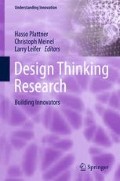Abstract
Design thinking asserts that individuals and teams have the ability to build their innovative capacity through various tools and methods no matter their predispositions to creativity and innovation. The contexts of design thinking attempt to alter design process towards more innovative ideas. This work attempts to experimentally disentangle the impact of disposition and situation during design activity. We present a variety of design contexts intended to be tested against dispositional factors during an experimental design task. We then present a pilot study exploring how process-priming impacts design process during a problem-solving task and an open-ended design task. Our preliminary results suggest that short process-priming activities may not be the most effective means for altering design process. Rather, more integrated contextual interventions may be better candidates for impacting design process and would be interesting test variables for future studies.
Access this chapter
Tax calculation will be finalised at checkout
Purchases are for personal use only
Notes
- 1.
This overall judgment was not a cumulative or mean score of the other categories, but rather a separate, holistic measure.
- 2.
While Mechanical Engineering Design may seem like a highly analytical field, the program at Stanford is highly enveloped in “design thinking.”
References
Asch SE (1956) Studies of independence and conformity: I. A minority of one against a unanimous majority. Psychol Monogr Gen Appl 70(9):1–70
Brown T (2008) Design thinking. Harv Bus Rev 86(6):84
Darley JM, Batson CD (1973) “From Jerusalem to Jericho”: a study of situational and dispositional variables in helping behavior. J Pers Soc Psychol 27(1):100–108. doi:10.1037/h0034449
Doorley S, Witthoft S (2012) Make space: how to set the stage for creative collaboration. Wiley, Hoboken, NJ
Dow SP, Glassco A, Kass J, Schwarz M, Schwartz DL, Klemmer SR (2010) Parallel prototyping leads to better design results, more divergence, and increased self-efficacy. ACM Trans Comput Hum Interact 17(4):1–24
Dow S, Fortuna J, Schwartz D, Altringer B, Schwartz D, Klemmer S (2011) Prototyping dynamics: sharing multiple designs improves exploration, group rapport, and results. In: Paper presented at the proceedings of the 2011 annual conference on human factors in computing systems
Eris Ö (2004) Effective inquiry for innovative engineering design: from basic principles to applications. Kluwer Academic, Norwell, MA
Goldsmith RE (1986) Personality and adaptive-innovative problem solving. J Soc Behav Pers 1(1):95–106
Kirton M (1976) Adaptors and innovators: a description and measure. J Appl Psychol 61(5):622–629. doi:10.1037/0021-9010.61.5.622
Kress GL, Schar M (2012) Teamology‚ the art and science of design team formation. In: Plattner H, Meinel C, Leifer L (eds) Design thinking research. Springer, Berlin, pp 189–209
Kruger C, Cross N (2006) Solution driven versus problem driven design: strategies and outcomes. Des Stud 27(5):527–548
Lang PJ (1980) Behavioral treatment and bio-behavioral assessment: computer applications. In: Sidowski JB, Johnson JH, Williams TA (eds) Technology in mental health care delivery systems. Ablex, Norwood, NJ, pp 119–137
Latane B, Darley JM (1968) Group inhibition of bystander intervention in emergencies. J Pers Soc Psychol 10(3):215–221. doi:10.1037/h0026570
Lawson BR (1979) Cognitive strategies in architectural design. Ergonomics 22(1):59–68
Mehta R, Zhu R (2009) Blue or red? Exploring the effect of color on cognitive task performances. Science 323(5918):1226–1229
Milgram S (1974) Obedience to authority. Harper & Row, New York
Hart SG, Staveland LE (1988) Development of NASA-TLX (Task Load Index): results of empirical and theoretical research. In: Hancock PA, Meshkati N (eds) Human mental workload. North Holland Press, Amsterdam
Plucker JA, Beghetto RA, Dow GT (2004) Why isn’t creativity more important to educational psychologists? Potentials, pitfalls, and future directions in creativity research. Educ Psychol 39(2):83–96. doi:10.1207/s15326985ep3902_1
Ross L (1977) The intuitive psychologist and his shortcomings: distortions in the attribution process. In: Leonard B (ed) Advances in experimental social psychology, vol 10. Academic, New York, pp 173–220
Ross L, Nisbett RE (1991) The person and the situation. Temple, Philadelphia, PA
Schön DA (1983) The reflective practitioner: how professionals think in action. Basic Books, New York
Scott SG, Bruce RA (1994) Determinants of innovative behavior: a path model of individual innovation in the workplace. Acad Manag J 37(3):580–607
Sternberg RJ (1985) Beyond IQ: a triarchic theory of human intelligence. Cambridge University Press, New York
Treffinger DJ, Isaksen SG, Dorval KB (1994) Creative problem solving: an overview. In: Runco MA (ed) Problem finding, problem solving, and creativity. Ablex, Hillsdale, NJ, pp 223–236
Woolley AW (2009) Means vs. ends: implications of process and outcome focus for team adaptation and performance. Organ Sci 20(3):500–515
Author information
Authors and Affiliations
Corresponding author
Editor information
Editors and Affiliations
Rights and permissions
Copyright information
© 2015 Springer International Publishing Switzerland
About this chapter
Cite this chapter
Martelaro, N., Ganguly, S., Steinert, M., Jung, M. (2015). The Personal Trait Myth: A Comparative Analysis of the Innovation Impact of Design Thinking Tools and Personal Traits. In: Plattner, H., Meinel, C., Leifer, L. (eds) Design Thinking Research. Understanding Innovation. Springer, Cham. https://doi.org/10.1007/978-3-319-06823-7_4
Download citation
DOI: https://doi.org/10.1007/978-3-319-06823-7_4
Published:
Publisher Name: Springer, Cham
Print ISBN: 978-3-319-06822-0
Online ISBN: 978-3-319-06823-7
eBook Packages: Business and EconomicsBusiness and Management (R0)

